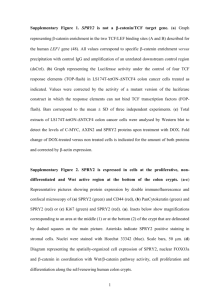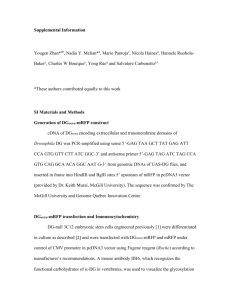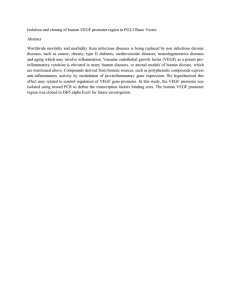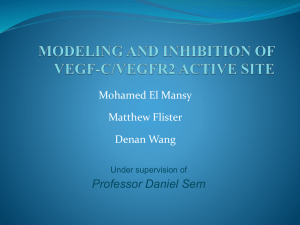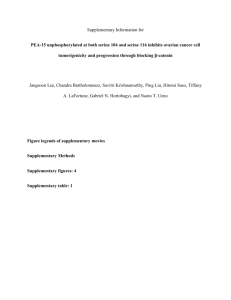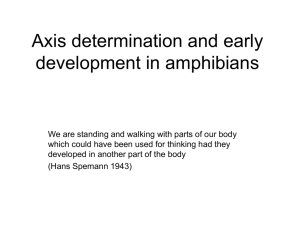Catenin - Circulation Research
advertisement
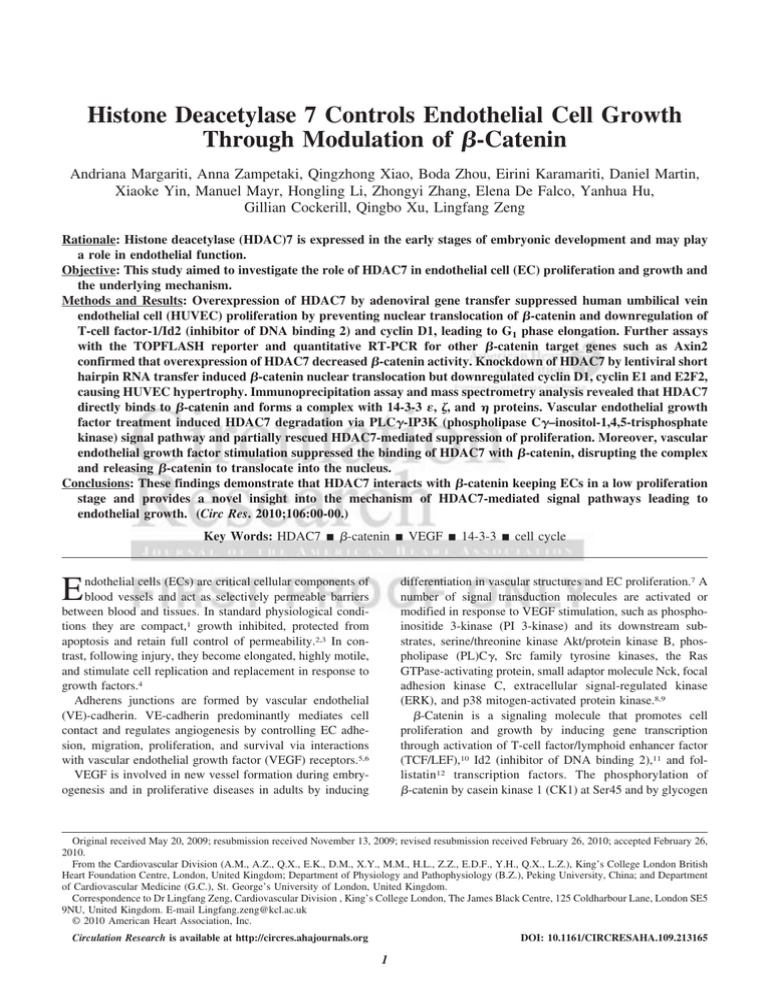
Histone Deacetylase 7 Controls Endothelial Cell Growth Through Modulation of -Catenin Andriana Margariti, Anna Zampetaki, Qingzhong Xiao, Boda Zhou, Eirini Karamariti, Daniel Martin, Xiaoke Yin, Manuel Mayr, Hongling Li, Zhongyi Zhang, Elena De Falco, Yanhua Hu, Gillian Cockerill, Qingbo Xu, Lingfang Zeng Rationale: Histone deacetylase (HDAC)7 is expressed in the early stages of embryonic development and may play a role in endothelial function. Objective: This study aimed to investigate the role of HDAC7 in endothelial cell (EC) proliferation and growth and the underlying mechanism. Methods and Results: Overexpression of HDAC7 by adenoviral gene transfer suppressed human umbilical vein endothelial cell (HUVEC) proliferation by preventing nuclear translocation of -catenin and downregulation of T-cell factor-1/Id2 (inhibitor of DNA binding 2) and cyclin D1, leading to G1 phase elongation. Further assays with the TOPFLASH reporter and quantitative RT-PCR for other -catenin target genes such as Axin2 confirmed that overexpression of HDAC7 decreased -catenin activity. Knockdown of HDAC7 by lentiviral short hairpin RNA transfer induced -catenin nuclear translocation but downregulated cyclin D1, cyclin E1 and E2F2, causing HUVEC hypertrophy. Immunoprecipitation assay and mass spectrometry analysis revealed that HDAC7 directly binds to -catenin and forms a complex with 14-3-3 , , and proteins. Vascular endothelial growth factor treatment induced HDAC7 degradation via PLC␥-IP3K (phospholipase C␥–inositol-1,4,5-trisphosphate kinase) signal pathway and partially rescued HDAC7-mediated suppression of proliferation. Moreover, vascular endothelial growth factor stimulation suppressed the binding of HDAC7 with -catenin, disrupting the complex and releasing -catenin to translocate into the nucleus. Conclusions: These findings demonstrate that HDAC7 interacts with -catenin keeping ECs in a low proliferation stage and provides a novel insight into the mechanism of HDAC7-mediated signal pathways leading to endothelial growth. (Circ Res. 2010;106:00-00.) Key Words: HDAC7 䡲 -catenin 䡲 VEGF 䡲 14-3-3 䡲 cell cycle E differentiation in vascular structures and EC proliferation.7 A number of signal transduction molecules are activated or modified in response to VEGF stimulation, such as phosphoinositide 3-kinase (PI 3-kinase) and its downstream substrates, serine/threonine kinase Akt/protein kinase B, phospholipase (PL)C␥, Src family tyrosine kinases, the Ras GTPase-activating protein, small adaptor molecule Nck, focal adhesion kinase C, extracellular signal-regulated kinase (ERK), and p38 mitogen-activated protein kinase.8,9 -Catenin is a signaling molecule that promotes cell proliferation and growth by inducing gene transcription through activation of T-cell factor/lymphoid enhancer factor (TCF/LEF),10 Id2 (inhibitor of DNA binding 2),11 and follistatin12 transcription factors. The phosphorylation of -catenin by casein kinase 1 (CK1) at Ser45 and by glycogen ndothelial cells (ECs) are critical cellular components of blood vessels and act as selectively permeable barriers between blood and tissues. In standard physiological conditions they are compact,1 growth inhibited, protected from apoptosis and retain full control of permeability.2,3 In contrast, following injury, they become elongated, highly motile, and stimulate cell replication and replacement in response to growth factors.4 Adherens junctions are formed by vascular endothelial (VE)-cadherin. VE-cadherin predominantly mediates cell contact and regulates angiogenesis by controlling EC adhesion, migration, proliferation, and survival via interactions with vascular endothelial growth factor (VEGF) receptors.5,6 VEGF is involved in new vessel formation during embryogenesis and in proliferative diseases in adults by inducing Original received May 20, 2009; resubmission received November 13, 2009; revised resubmission received February 26, 2010; accepted February 26, 2010. From the Cardiovascular Division (A.M., A.Z., Q.X., E.K., D.M., X.Y., M.M., H.L., Z.Z., E.D.F., Y.H., Q.X., L.Z.), King’s College London British Heart Foundation Centre, London, United Kingdom; Department of Physiology and Pathophysiology (B.Z.), Peking University, China; and Department of Cardiovascular Medicine (G.C.), St. George’s University of London, United Kingdom. Correspondence to Dr Lingfang Zeng, Cardiovascular Division , King’s College London, The James Black Centre, 125 Coldharbour Lane, London SE5 9NU, United Kingdom. E-mail Lingfang.zeng@kcl.ac.uk © 2010 American Heart Association, Inc. Circulation Research is available at http://circres.ahajournals.org DOI: 10.1161/CIRCRESAHA.109.213165 1 2 Circulation Research April 16, 2010 Non-standard Abbreviations and Acronyms Ad-HD7 Ad-tTA BrdUrd HA HDAC HUVEC Id2 IP3 IP3K LEF moi MTT PLC Rb shRNA VE VEGF HDAC7 adenovirus tetracycline-controlled transactivator tTA adenovirus bromodeoxyuridine hemagglutinin histone deacetylase human umbilical vein endothelial cell inhibitor of DNA binding 2 inositol-1,4,5-trisphosphate inositol-1,4,5-trisphosphate kinase lymphoid enhancer factor multiplicity of infection 3-(4,5-dimethylthiazol-2-yl)-2,5-diphenyl tetrazolium bromide phospholipase C retinoblastoma short hairpin RNA vascular endothelial vascular endothelial growth factor synthase kinase 3 (GSK3) at Thr41, Ser37, and Ser33, targets -catenin for ubiquitination and degradation through the proteasome. Mitogenic factors promote -catenin signaling through inhibition of GSK3. This reduces the phosphorylation of -catenin and increases its nuclear accumulation where it stimulates TCF/LEF-dependent gene transcription.13 Therefore, the stability and/or subcellular localization of -catenin can be affected by multiple signaling events. However, there is not sufficient information to fully explain how the stabilization and cytoplasmic-nuclear translocation of -catenin are regulated. Histone deacetylases (HDACs) regulate several biological processes such as cell-cycle, cell differentiation and survival.14 –17 Histone deacetylase (HDAC)7 is a member of the class II HDACs and is expressed in the vascular endothelium during early embryogenesis where it maintains vascular integrity.18 Silencing of HDAC7 in ECs alters their morphology and motility and prevents their assembly into tube-like structures.19 Furthermore, VEGF induces HDAC, and in particular HDAC7 phosphorylation. The responsive phosphorylation sites in HDAC7 are critical for VEGFinduced EC proliferation.20,21 Therefore, HDAC7 is critical during angiogenesis and mainly functions as a transcriptional repressor for genes such as membrane type 1 metalloprotease and matrix metalloproteinase-10.20 However, the detailed mechanisms of how HDAC7 is involved in these key angiogenic processes is still unclear. In this study we demonstrate that HDAC7 controls EC growth through modulation of -catenin and maintains ECs in a low proliferation stage. Methods An expanded Methods section is available in the Online Data Supplement at http://circres.ahajournals.org. Figure 1. Elevated HDAC7 suppresses EC proliferation via prevention of -catenin translocation. A, Overexpression of HDAC7 decreases metabolism (MTT) and BrdUrd incorporation. HUVECs were uninfected (Ctl) or infected with Ad-HD7 or Ad-tTA. MTT and BrdUrd assays were performed 48 hour after infection. *P⬍0.05. B, Fluorescenceactivated cell-sorting analysis revealed that overexpression of HDAC7 in HUVECs prevents the G1/S phase transition. C and D, Overexpression of HDAC7 decreases cyclin D1, Id2, and TCF-1 expression at the RNA level by real-time PCR (*P⬍0.05) (C) or at the protein level by Western blot (D) 48 hours after infection. ␣-Tubulin was included as loading control. Overexpression of HDAC7 increases active -catenin levels but decreases its target gene expression, Id2 and TCF-1. E, HDAC7 overexpression retains -catenin in the cytoplasm. Double immunofluorescence staining was performed 48 hours after infection. Exogenous HDAC7 was revealed by anti-HA antibody. DAPI was used to stain the cell nucleus (bar, 100 m). F and G, TOP-FLASH reporter gene assay (F) and real-time PCR for Axin2 (G) confirmed that overexpression of HDAC7 decreases -catenin activity. Margariti et al HDAC7 in EC Growth 3 Figure 2. Knockdown of HDAC7 causes EC hypertrophy. A, HUVECs were uninfected (Ctl) or infected with nontarget (Non) or HDAC7 (shHD7) shRNA. Knockdown of HDAC7 increases cell size 72 hours after infection (bar, 50 m). B, Knockdown of HDAC7 increases HUVEC size as revealed by cell size calculation at 24, 48, and 72 hours after infection using Beckman Coulter. Uninfected (Ctl) and nontarget shRNA (Non) were included as controls. *P⬍0.05. C, Knockdown of HDAC7 increases metabolism (MTT) but decreases BrdUrd incorporation, 72 hours after infection. *P⬍0.05. D, The expression of -catenin target genes was increased by knockdown of HDAC7. Real-time PCR was performed at 72 hours after infection. *P⬍0.05. E, Knockdown of HDAC7 increases -catenin localization in nucleus. Double-immunofluorescence staining was performed 72 hours after infection with shRNA lentiviral particles (bar, 100 m). F, Knockdown of HDAC7 decreases cyclin D1, E1, and E2F2 expression. Real-time PCR was performed at 72 hours after infection. *P⬍0.05. G, The expression of Rb, cyclin D1, and E2F2, and -catenin active proteins was evaluated by Western blot analysis. Cell Culture Human umbilical vein endothelial cells (HUVECs) were isolated from the human umbilical cord and cultured on collagen I– coated flasks in EGM-2 medium (Clonetics) or in M199 medium supplemented with 1 ng/mL -EC growth factor (SIGMA), 3 g/mL EC Growth Supplement from bovine neural tissue (Sigma), 10 U/mL heparin, 1.25 g/mL thymidine, 5% FBS (PAA, A15-108),22 and 100 g/mL penicillin and streptomycin. Ad-Virus Construction The Ad-HDAC7 viral DNA (Ad-HD7) was constructed as described previously.23 Results Elevated HDAC7 Suppresses EC Proliferation via Prevention of -Catenin Translocation To explore the function of HDAC7 in the maintenance of EC homeostasis, we first studied the effect of HDAC7 overexpression by adenoviral gene transfer (Ad-HD7) on HUVEC proliferation. Overexpression of HDAC7 did not alter HUVEC morphology (Online Figure I, A and B); however, the growth rate of HUVECs decreased. Ad-HD7–infected cells required longer to reach confluence as compared to uninfected or tetracycline-controlled transactivator tTA adenovirus (Ad-tTA)–infected cells, as revealed by a decrease in 3-(4,5-dimethylthiazol-2-yl)-2,5-diphenyl tetrazolium bromide (MTT)-based mitochondrial enzyme activity, BrdUrd incorporation assays (Figure 1A), and cell number counting (Online Figure I, C). No increases in apoptosis and caspase activation were detected in Ad-HD7–infected cells (Online Figure II, A and B). Furthermore fluorescence-activated cell-sorting analysis demonstrated that overexpression of HDAC7 in HUVECs prevented the G1/S phase transition (Figure 1B). The -catenin pathway plays an important role in EC growth and G1/S phase transition. We wondered whether HDAC7 suppressed EC proliferation through modulation of this pathway. To test this we examined the effect of HDAC7 overexpression on -catenin target gene expression. As shown in Figure 1C, cyclin D1, Id2, and TCF-1 mRNAs were significantly decreased in Ad-HD7–infected HUVECs. The decrease of cyclin D1 was further confirmed by Western blot (Figure 1D). The mRNA (Figure 1G) and protein levels (Figure 1D) of -catenin itself did not change in Ad-HD7– infected cells as compared to control virus-infected cells. Actually, the active form of -catenin was increased in Ad-HD7–infected cells (Figure 1D). Therefore, the decrease in the expression of these genes might be attributable to reduced nuclear localization of -catenin. Double immunofluorescence staining revealed that in uninfected or Ad-tTA virus-infected HUVECs, -catenin was exclusively located in the pericellular junctions (Figure 1E, top) in confluent cells. Most subconfluent cells showed similar -catenin staining with only a few cells showing nuclear localization (Online Figure I, D). In contrast, in Ad-HD7–infected cells, -catenin localized to both the pericellular junctions and the cytoplasm. Very little staining was observed in the nucleus (Figure 1E, bottom). There was a strong colocalization of -catenin and 4 Circulation Research April 16, 2010 Figure 3. HDAC7 binds to -catenin. A and B, Coimmunoprecipitation assays show the direct binding of -catenin to endogenous HDAC7 (A; left, immunoprecipitation [IP] with HDAC7; right, immunoprecipitation with -catenin) and exogenous HDAC7 (B; left, immunoprecipitation with HA; right, immunoprecipitation with -catenin). C, Immunostaining shows the different localization pattern of HDAC7 in different cells. Top, Cytoplasmic localization of HDAC7 in the majority of cells. Bottom, Nuclear localization of HDAC7 in a small portion of the cells. Bar, 100 m. D, En face staining of arteries obtained from wild-type mice showed that HDAC7 is predominantly expressed in the cytoplasm. Double staining of HDAC7 (red) and CD31 (green) defined the endothelium monolayer in these samples. Bar, 50 m. E, Western blots show that HDAC7 localization occurs in a multiplicity of infection– dependent manner. HUVECs were infected with 10 or 100 mois. HDAC7 localization was detected by cellular fractionation and Western blot 48 hours after infection. ␣-Tubulin and H4 were included as loading controls for cytoplasmic and nuclear fractions, respectively. High multiplicities of infection of Ad-HD7 virus infection increases HDAC7 nuclear localization. HDAC7 in the cytoplasm. This observation was confirmed by other experiments described later. Further assays with the TOPFLASH reporter (Figure 1F) and quantitative RT-PCR for other -catenin target genes such as Axin2 (Figure 1G) confirmed that overexpression of HDAC7 decreased -catenin activity. These results suggest that overexpression of HDAC7 suppresses EC proliferation through retention of -catenin in the cytoplasm and downregulation of cyclin D1. Knockdown of HDAC7 Causes EC Hypertrophy Because overexpression of HDAC7 suppressed EC proliferation, we hypothesized that downregulation of HDAC7 could increase EC proliferation. To test this, we knocked down HDAC7 mRNA via short hairpin (sh)RNA lentiviral particles. Downregulation of HDAC7 mRNA did not affect the expression of other HDACs (Online Figure III, A). Knockdown of HDAC7 resulted in enlarged cells as compared to uninfected or nontargeting shRNA lentivirus-infected cells (Figure 2A). Calculation of the cell size confirmed that HDAC7 shRNA lentivirus-infected cells were significantly larger (Figure 2B). Furthermore, knockdown of HDAC7 increased MTT-based mitochondrial enzyme activity, but surprisingly BrdUrd incorporation (Figure 2C) and cell counts (data IIIB) were decreased. In contrast to the overexpression data, knockdown of HDAC7 upregulated LEF1 and TCF3-tv1 expression (Figure 2D). In concert with this, translocation of -catenin to the nucleus was enhanced by knockdown of HDAC7 (Figure 2E). H3 nuclear staining was included as a positive control and is shown in Online Figure IV. However, knockdown of HDAC7 downregulated cyclin D1 and E1 mRNA (Figure 2F) and protein (Figure 2G) expression, but increased retinoblastoma (Rb) protein (Figure 2G). This leads to downregulation of E2F2 expression, whereas the -catenin active form did not change (Figure 2F and 2G). These results suggest that HDAC7 deficiency induces EC hypertrophy by increasing -catenin translocation via modulation of the cyclins/Rb pathway. HDAC7 Binds to -Catenin We hypothesized that HDAC7 and -catenin may interact directly. Coimmunoprecipitation experiments were performed to test this hypothesis. Indeed, direct binding of -catenin to endogenous HDAC7 (Figure 3A; left, IP with HDAC7; right, IP with -catenin) and exogenous HDAC7 (Figure 3B; left, IP with hemagglutinin [HA]; right, IP with -catenin) was observed. HDAC7 is a shuttle protein and traffics between the cytoplasm and the nucleus. To identify the localization of HDAC7 in our culture conditions, immunofluorescence staining for endogenous HDAC7 was performed. HDAC7 predominantly localized to the cytoplasm in HUVECs (Figure 3C, top). HDAC7 was only localized to the nucleus in a small portion of the cells (Figure 3C, top). A similar phenomenon was observed in intact ECs in vivo. En face staining of arteries obtained from wild type mice showed that HDAC7 is predominantly expressed in the cytoplasm (Figure 3D). In vitro, in our overexpression system the localization of HDAC7 was multiplicity of infection (moi)dependent. Specifically, HDAC7 mainly localized to the cytoplasm at low multiplicities of infection, such as 10 mois (Figure 3E). However, at high multiplicities of infection (eg, 100 mois), HDAC7 predominantly localized to the nucleus (Figure 3E). These data indicate that HDAC7 is mainly expressed in the cytoplasm under physiological conditions. Margariti et al HDAC7 in EC Growth 5 VEGF Induces HDAC7 Protein Degradation Through the PLC␥-IP3 Kinase Pathway Figure 4. HDAC7 links 14-3-3 , , and proteins and -catenin to form a complex. A, Silver staining shows the HDAC7 associated proteins. HUVECs were infected with AdtTA– or Ad-HD7– and HDAC7-associated proteins were pulled down by anti-HA antibody and observed by silver staining (left). Right, Enlarged image. Bands a, b, c, and d were identified as 14-3-3 , , and by mass spectrometry. B, Coimmunoprecipitation assays confirmed the binding of HDAC7 with the 14-3-3 isoforms in HUVECs. C, -Catenin bound to VE-cadherin but not to 14-3-3 . HDAC7 Links 14-3-3 , , Proteins and -Catenin to Form a Complex To better understand how HDAC7 regulates the stabilization and translocation of -catenin, HDAC7-associated proteins were isolated and analyzed by mass spectrometry in Ad-HD7–infected HUVECs as compared to control virus-infected cells (Figure 4A; Online Table II). The 14-3-3 , , and proteins were pulled down by HA antibody in Ad-HD7 infected cells. These results were further confirmed by coimmunoprecipitation assays (Figure 4B). Stabilization of -catenin in the cytoplasm is regulated by the 14-3-3 isoform.24 We hypothesized that the 14-3-3 isoforms might bind directly to -catenin or indirectly through HDAC7. Coimmunoprecipitation with anti–-catenin antibody could not detect the binding of the 14-3-3 isoform, despite the association of -catenin with VE-cadherin being detected (Figure 4C). This was also true with the 14-3-3 , and isoforms (data not shown). Coimmunoprecipitation with 14-3-3 was also performed and confirmed the above findings (Online Figure V). These results suggest that the 14-3-3 proteins may indirectly associate with -catenin and that HDAC7 may act as a scaffold or docking site that stabilizes the complex and retains -catenin in the cytoplasm. VEGF is a well-known mitogenic growth factor for ECs that modulates the VE-cadherin–-catenin complex and nuclear translocation of -catenin. We showed that HDAC7 bound and retained -catenin in the cytoplasm. Thus, we postulated that crosstalk between VEGF signaling and HDAC7 may occur. First we detected the protein level of HDAC7 in VEGF-treated HUVECs by Western blot analysis. VEGF treatment rapidly decreased endogenous HDAC7 protein expression within 5 to 10 minutes via protein degradation (Figure 5A). Furthermore VEGF treatment suppressed the transcription of HDAC7 as demonstrated by luciferase reporter assays (Online Figure VI, A) and conventional and quantitative RT-PCR (Figure Online VI, B and C). VEGF binding to its receptors can trigger multiple signal pathways. Selective inhibitors were used to distinguish the signaling pathway involved in VEGF-mediated HDAC7 degradation. HUVECs were pretreated for 1 hour with SU1498 (tyrosine kinase inhibitor), U73122 (PLC␥ inhibitor), R59022 (diacylglycerol kinase inhibitor), LY294002 (phosphatidylinositol 3-kinase/AKT inhibitor), PD98059 (mitogen-activated protein kinase inhibitor), and inositol-1,4,5trisphosphate (IP3) (IP3 kinase [IP3K] inhibitor) before 20 ng/mL VEGF treatment for 10 minutes. Western blot analysis showed that both U73122 and IP3 block VEGF-induced HDAC7 protein degradation, whereas the other inhibitors had no effect (Figure 5B). Furthermore U73122 and IP3K inhibitors block VEGF-mediated suppression of HDAC7 in a dose-dependent manner (Figure 5C). These results indicate that VEGF induces HDAC7 degradation through the PLC␥IP3K signal pathway. Moreover VEGF-induced HDAC7 degradation was ablated by MG132 treatment (Figure 5D), suggesting that degradation of HDAC7 is mediated through the proteasome. Finally, VEGF treatment decreased HDAC7 binding to -catenin, whereas the binding of 14-3-3 to exogenous HDAC7, which is not fully degraded by VEGF, increased (Figure 5E). HDAC7 Modulates VEGF-Mediated -Catenin Translocation VEGF induced HDAC7 degradation, whereas the cellular localization of -catenin was related to the HDAC7 protein level. Therefore, HDAC7 may be involved in VEGF-induced -catenin translocation. To explore this, the distribution of cytoplasmic and nuclear -catenin was detected after VEGF treatment and overexpression of HDAC7 by adenoviral gene transfer. As expected, 10 minutes of VEGF stimulation downregulated endogenous HDAC7 protein levels and increased the nuclear versus cytoplasmic ratio of -catenin (Figure 6A [left] and 6B). To confirm this finding, we performed immunofluorescence staining to determine the nuclear localization of -catenin on VEGF treatment (Figure 6D). However, when HDAC7 was overexpressed, the ratio of nuclear to cytoplasmic -catenin decreased and VEGF no longer induced nuclear translocation of -catenin. In fact the nuclear portion was reduced (Figure 6A [right] and 6B). Moreover in cells overexpressing HDAC7 VEGF no longer exerts a proliferative effect (Figure 6C). However, by increas- 6 Circulation Research April 16, 2010 Figure 5. VEGF induces HDAC7 protein degradation through the PLC␥-IP3K pathway. A, VEGF treatment decreases HDAC7 protein level. HUVECs were treated with VEGF (20 ng/mL) for the indicated time. HDAC7 protein level is decreased as early as 5 minutes after treatment, as revealed by Western blot analysis; ␣-tubulin was used as a loading control. B, VEGF induces HDAC7 degradation through the PLC␥-IP3K signal pathway. HUVECs were pretreated with specific inhibitors for 1 hour, followed by treatment with 20 ng/mL VEGF for 10 minutes in the presence of inhibitors. EOH indicates ethanol; U73, U73122 (PLC inhibitor); R59, R59022 (diacylglycerol kinase inhibitor); SU14, SU1498; LY29, LY294002; PD89, PD98059; IP3K (IP3K inhibitor). C, U73122 and IP3K inhibitors attenuate VEGF-induced HDAC7 degradation in a dose-dependent manner (U73122: 0.25 to 1 mol/L; IP3K: 1.25 to 5 mol/ L). D, MG132 inhibitor ablates VEGF-induced HDAC7 degradation. HUVECs were pretreated with MG132 for 6 hours before VEGF treatment for 10 minutes in the presence of the inhibitor. HDAC7 protein level was detected by Western blot (top) and 3 independent experiments were quantified (bottom). E, VEGF decreases binding of exogenous HDAC7 to -catenin but increases its binding to 14-3-3 proteins. Coimmunoprecipitation experiments were performed in the absence or presence of VEGF treatment for 10 minutes. HA antibody was used to pull down exogenous HDAC7 and its associated proteins. ing VEGF stimulation (100 ng/mL) the inhibitory effect of Ad-HD7 on -catenin nuclear translocation can be partially overcome as revealed by double immunostaining experiments (Figure 6E). Interestingly, stimulation of cells overexpressing Ad-HD7 with Wnt3a ligand, which mediates -catenin nuclear translocation,25 reduced -catenin nuclear translocation (Online Figure VII). These results further support the notion that HDAC7 is involved in the regulation of -catenin translocation. Discussion The homeostasis between histone acetylation and deacetylation modulates chromosome structure, acting as a switch for gene transcription. This activity is key in cell proliferation and survival. HDACs represent an important protein family as they control histone acetylation status26 and modulate gene expression through association and dissociation of sequencespecific DNA-binding transcription factors.27 In this study, we found that HDAC7 formed a complex with -catenin and 14-3-3 , , and proteins. HDAC7 also modulated the cellular localization of -catenin, the expression of -catenin target genes and cell cycle–related genes. Elevated HDAC7 retained -catenin in the cytoplasm, whereas HDAC7 deficiency increased nuclear translocation of -catenin. VEGF suppressed HDAC7 transcription and induced HDAC7 degradation through the PLC␥-IP3K pathway, resulting in nuclear translocation of -catenin. Overexpression of HDAC7 ablated VEGF-induced -catenin translocation and EC proliferation. These findings suggest that HDAC7 is crucial in the regulation of EC growth and proliferation. HDACs are involved in cell cycle regulation through modulation of gene transcription. HDAC1 controls cell cycle progression through Rb/E2F28 or p53/p21.29 HDAC4 inhibits cell cycle progression, increases cell survival30 and plays a role in the repression of cardiac hypertrophy,31 demonstrating its important role in the cell cycle. In our study, both overexpression and knockdown of HDAC7 downregulated cyclin D1 and caused cell cycle elongation at G1 phase, suggesting that tight regulation of the HDAC7 protein level is important for EC cycle progression. Further research is required to elucidate this important and tightly regulated process. Recently, disruption of the HDAC7 gene in mice was shown to disrupt endothelial cell– cell adhesion and to enlarge the branchial arteries.18 The enlargement of the branchial arteries may imply an increase in EC number or size. Indeed, in our experiments knockdown of HDAC7 increased HUVEC size with a concomitant increase in cellular metabolism. These data suggest that HDAC7 regulates EC cycle and growth. -Catenin is essential in both cell– cell adhesion and Wnt signal transduction. However the precise control over -catenin targeting to cadherin adhesive complexes, or TCFtranscriptional complexes is poorly understood. The intracellular domains of VE-cadherin bind to -catenin, p71, p120 and plakoglobin.32 The whole complex modulates cell-to-cell communication, controls intercellular permeability and mediates the contact inhibition of cell proliferation by preventing translocation of -catenin into the nucleus.32,33 It is believed that participation of -catenin in adhesion of Wnt signaling is dictated by the regulation of distinct molecular Margariti et al HDAC7 in EC Growth 7 Figure 6. HDAC7 prevents -catenin translocation to the nucleus. A, Overexpression of HDAC7 blocked VEGF-induced -catenin translocation. HUVECs were infected for 48 hours, followed by VEGF treatment for 10 minutes. Cellular localization of HDAC7 and -catenin was detected by Western blot in the cytoplasm and nuclear fractions. Endogenous and exogenous HDAC7 were detected by anti-HDAC7 and anti-HA antibodies, respectively. ␣-Tubulin and H4 were included as loading controls for cytoplasmic and nuclear fractions, respectively. VEGF suppresses endogenous HDAC7 expression and induces nuclear localization of -catenin, which is ablated by overexpression of exogenous HDAC7. The ratio of nuclear to cytoplasmic -catenin in the presence of HDAC7 is decreased. B, Quantification and statistical analysis. *P⬍0.05. C, Proliferation assays show that overexpression of HDAC7 ablates VEGF-induced EC proliferation. D, Double immunofluorescence staining confirmed the nuclear localization of -catenin after VEGF treatment. Bars, 100 m and 50 m, respectively. E, Treatment with high VEGF concentration (100 ng/mL) partially overcomes the blockage of nuclear -catenin by Ad-HD7 in HUVECs overexpressing Ad-HD7. Bar, 100 m. forms of -catenin with different binding properties, rather than simple competition between cadherins and TCFs for a single constitutive form.34 However, the regulation of the distinct molecular forms of -catenin remains unknown. HDAC1 and HDAC2 regulate oligodendrocyte differentiation by disrupting the -catenin–TCF interaction,35 which suggests that HDACs are important regulators of -catenin interactions. On VEGF treatment, VEGF receptor 2 phosphorylates VE-cadherin36 and -catenin, leading to degradation of VE-cadherin, nuclear translocation of -catenin and transcription of proliferation-related genes.37 In our study, we found that overexpression of HDAC7 ablated VEGF-induced -catenin translocation and EC proliferation, whereas knockdown of HDAC7 by shRNA increased -catenin translocation and EC growth. Therefore, HDAC7 downregulation by VEGF plays a critical role in the stabilization of -catenin in the cytoplasm. VEGF is a growth factor and induces angiogenesis by increasing EC proliferation and migration. Several signaling pathways are activated by VEGF treatment, such as the phosphatidylinositol 3-kinase/Akt pathway that mediates cell survival,5 the extracellular signal-regulated kinase/mitogenactivated protein kinase pathway that influences cell prolif- eration and apoptosis and the VE-cadherin/-catenin/Wnt pathway that regulates cell proliferation.38,39 VEGF treatment can also induce quiescent cells to re-enter the cell cycle. As the protein level of HDAC7 affects EC growth and cell cycle progression, it is postulated that crosstalk between VEGF signaling and HDAC7 may occur and that HDAC7 is involved in VEGF-induced EC growth and proliferation. Indeed, our results showed that VEGF suppressed HDAC7 transcription and induced a rapid and transient degradation of HDAC7. Additionally, experiments performed in the presence of the proteasome inhibitor MG132 demonstrated that VEGF induced degradation of HDAC7 occurred through the proteasome. MG132 alone also degraded HDAC7, as shown previously.40 Further studies revealed that the PLC␥-IP3K signal pathway is involved in VEGF-mediated HDAC7 degradation. The transiently reduced levels of HDAC7 in response to VEGF resulted in a prompt increase in nuclear translocation of -catenin and enhanced EC proliferation. In concert with this, when VEGF cannot effectively decrease exogenous HDAC7 protein following HDAC7 overexpression, it could neither increase nuclear translocation of -catenin nor trigger EC proliferation. Indeed, with increasing VEGF stimulation (100 ng/mL), the blockage of nuclear 8 Circulation Research April 16, 2010 Figure 7. A schematic illustration shows the role of HDAC7 in the control of EC growth. HDAC7 acts as a bridge between 14-3-3 , , , and -catenin and stabilizes -catenin in the cytoplasm, resulting in inhibition of EC growth and leading to G1 phase elongation. VEGF treatment increases HDAC7 degradation, releasing -catenin from the HDAC7–-catenin–14-3-3 complex, leading to the translocation of -catenin to the nucleus. The overall effect is an increase in -catenin target gene expression and EC growth. -catenin by HDAC7 overexpression was partially overcome, whereas stimulation of cells overexpressing HDAC7 with a wnt3a ligand reduced nuclear translocation of -catenin. The localization of HDAC7 is crucial for its function. Previous studies suggest that HDAC7 is a shuttle protein and is detected both in the cytosol and the nucleus. We found that the experimental design and culture conditions such as cell confluence, culture media, the presence or absence of growth factors (eg, VEGF, endothelial cell growth factor) influenced the localization of HDAC7. Overexpression of HDAC7 could also alter its subcellular location, with lower multiplicities of infection (eg, 10 mois) resulting in cytoplasmic localization and higher multiplicities of infection (eg, 100 mois) resulting in nuclear localization. To overcome the limitations of the in vitro systems we performed an en face staining of ECs on perfused arteries obtained from wild type mice. These experiments indicated that HDAC7 protein in ECs in vivo is mainly cytoplasmic. This further supports the notion that HDAC7 translocation to the nucleus is a tightly monitored process. The 14-3-3 proteins seem to affect HDAC7 localization by controlling the stabilization of cytoplasmic HDAC7 and protecting it from proteolysis.40,41 Members of this family also form a complex with -catenin and increase its steadystate levels in the cytoplasm.24 Our experiments demonstrated that HDAC7 formed a complex with 14-3-3 , , and proteins and -catenin. However, a detailed analysis of the function of the various 14-3-3 members in this complex went beyond the scope of the present work. Nevertheless, initial experiments suggested an important role for 14-3-3 . It bound directly to HDAC7 but not to -catenin. This may indicate that HDAC7 functions as a scaffold that provides docking sites for 14-3-3 proteins and -catenin and facilitates their binding in a stable complex. Formation of this complex stabilizes -catenin in the cytoplasm. However, further experiments are needed to explore this aspect. Phosphorylation of HDAC7 in response to VEGF stimulation adds an additional layer of regulation. VEGF stimulates PLC␥, which activates protein kinase C, leading to HDAC7 phosphorylation and its cytoplasmic accumulation.20 Moreover, VEGF-induced phosphorylation of HDAC7 influences its export from the nucleus and controls migration and proliferation in ECs.21 Of note, when a mutant form of HDAC7 that cannot be phosphorylated was applied, VEGF failed to induce proliferation of ECs. In our experiments, expression of the mutant HDAC7 also severely suppressed VEGF induced proliferation but had no effect at baseline conditions. In contrast wild type HDAC7 that can be phosphorylated and localized to both the cytosol and the nucleus had an inhibitory effect on proliferation in the presence or Margariti et al absence of VEGF (Online Figure VIII). Because the mutated form localized to the nucleus, these experiments underline the significance of the cytoplasmic HDAC7 that exerts unique functions in the cell. Importantly, different HDAC7 splicing isoforms have distinct cellular localizations, which may explain their different functions.23 Thus, it will be interesting to study the HDAC7 isoforms in ECs and to explore whether VEGF regulates such splicing events and modulates their functions. It seems that the localization and expression of HDAC7 could direct a number of VEGF-stimulated signaling pathways to regulate HDAC7 phosphorylation and degradation. Further studies are required to elucidate the above aspects. In summary, this study provides evidence that HDAC7 controls EC proliferation through the modulation of -catenin stabilization. HDAC7 bridges 14-3-3 , , and -catenin and stabilizes -catenin in the cytoplasm, resulting in inhibition of EC growth and leading to the elongation of G1 phase. VEGF-induced degradation of HDAC7 disrupts this complex and leads to the translocation of -catenin to the nucleus, which induces EC growth (Figure 7). This study provides novel insights into the mechanisms involved in EC growth. Acknowledgments We thank Dr John Paul Kirton for critical reading of the manuscript and Dr Alexander Kapustin for his kind help using the Multisizer 3 Coulter Counter (Beckman Coulter). Sources of Funding British Heart Foundation and Oak Foundation. Disclosures None. References 1. Dejana E, Spagnuolo R, Bazzoni G. Interendothelial junctions and their role in the control of angiogenesis, vascular permeability and leukocyte transmigration. Thromb Haemost. 2001;86:308 –315. 2. Liebner S, Cavallaro U, Dejana E. The multiple languages of endothelial cell-to-cell communication. Arterioscler Thromb Vasc Biol. 2006;26: 1431–1438. 3. Foteinos G, Hu Y, Xiao Q, Metzler B, Xu Q. Rapid endothelial turnover in atherosclerosis-prone areas coincides with stem cell repair in apolipoprotein E-deficient mice. Circulation. 2008;117:1856 –1863. 4. Dejana E. Endothelial cell-cell junctions: happy together. Nat Rev. 2004; 5:261–270. 5. Gerber HP, McMurtrey A, Kowalski J, Yan M, Keyt BA, Dixit V, Ferrara N. Vascular endothelial growth factor regulates endothelial cell survival through the phosphatidylinositol 3⬘-kinase/Akt signal transduction pathway. Requirement for Flk-1/KDR activation. J Biol Chem. 1998;273: 30336 –30343. 6. Lampugnani MG, Orsenigo F, Gagliani MC, Tacchetti C, Dejana E. Vascular endothelial cadherin controls VEGFR-2 internalization and signaling from intracellular compartments. J Cell Biol. 2006;174:593– 604. 7. Carmeliet P, Jain RK. Angiogenesis in cancer and other diseases. Nature. 2000;407:249 –257. 8. Claesson-Welsh L. Signal transduction by vascular endothelial growth factor receptors. Biochem Soc Trans. 2003;31:20 –24. 9. Carmeliet P. Mechanisms of angiogenesis and arteriogenesis. Nat Med. 2000;6:389 –395. 10. Gottardi CJ, Gumbiner BM. Adhesion signaling: how beta-catenin interacts with its partners. Curr Biol. 2001;11:R792–R794. 11. Rockman SP, Currie SA, Ciavarella M, Vincan E, Dow C, Thomas RJ, Phillips WA. Id2 is a target of the beta-catenin/T cell factor pathway in colon carcinoma. J Biol Chem. 2001;276:45113– 45119. HDAC7 in EC Growth 9 12. Willert J, Epping M, Pollack JR, Brown PO, Nusse R. A transcriptional response to Wnt protein in human embryonic carcinoma cells. BMC Dev Biol. 2002;2:8. 13. Taurin S, Sandbo N, Qin Y, Browning D, Dulin NO. Phosphorylation of beta-catenin by cyclic AMP-dependent protein kinase. J Biol Chem. 2006;281:9971–9976. 14. Zeng L, Xiao Q, Margariti A, Zhang Z, Zampetaki A, Patel S, Capogrossi MC, Hu Y, Xu Q. HDAC3 is crucial in shear- and VEGF-induced stem cell differentiation toward endothelial cells. J Cell Biol. 2006;174: 1059 –1069. 15. Lee JH, Hart SR, Skalnik DG. Histone deacetylase activity is required for embryonic stem cell differentiation. Genesis. 2004;38:32–38. 16. Chang S, McKinsey TA, Zhang CL, Richardson JA, Hill JA, Olson EN. Histone deacetylases 5 and 9 govern responsiveness of the heart to a subset of stress signals and play redundant roles in heart development. Mol Cell Biol. 2004;24:8467– 8476. 17. Shin HJ, Baek KH, Jeon AH, Kim SJ, Jang KL, Sung YC, Kim CM, Lee CW. Inhibition of histone deacetylase activity increases chromosomal instability by the aberrant regulation of mitotic checkpoint activation. Oncogene. 2003;22:3853–3858. 18. Chang S, Young BD, Li S, Qi X, Richardson JA, Olson EN. Histone deacetylase 7 maintains vascular integrity by repressing matrix metalloproteinase 10. Cell. 2006;126:321–334. 19. Mottet D, Bellahcene A, Pirotte S, Waltregny D, Deroanne C, Lamour V, Lidereau R, Castronovo V. Histone deacetylase 7 silencing alters endothelial cell migration, a key step in angiogenesis. Circ Res. 2007;101: 1237–1246. 20. Ha CH, Jhun BS, Kao HY, Jin ZG. VEGF stimulates HDAC7 phosphorylation and cytoplasmic accumulation modulating matrix metalloproteinase expression and angiogenesis. Arterioscler Thromb Vasc Biol. 2008;28:1782–1788. 21. Wang S, Li X, Parra M, Verdin E, Bassel-Duby R, Olson EN. Control of endothelial cell proliferation and migration by VEGF signaling to histone deacetylase 7. Proc Natl Acad Sci U S A. 2008;105:7738 –7743. 22. Zeng L, Zampetaki A, Margariti A, Pepe AE, Alam S, Martin D, Xiao Q, Wang W, Jin ZG, Cockerill G, Mori K, Li YS, Hu Y, Chien S, Xu Q. Sustained activation of XBP1 splicing leads to endothelial apoptosis and atherosclerosis development in response to disturbed flow. Proc Natl Acad Sci U S A. 2009;106:8326 – 8331. 23. Margariti A, Xiao Q, Zampetaki A, Zhang Z, Li H, Martin D, Hu Y, Zeng L, Xu Q. Splicing of HDAC7 modulates the SRF-myocardin complex during stem-cell differentiation towards smooth muscle cells. J Cell Sci. 2009;122:460 – 470. 24. Tian Q, Feetham MC, Tao WA, He XC, Li L, Aebersold R, Hood L. Proteomic analysis identifies that 14-3-3zeta interacts with beta-catenin and facilitates its activation by Akt. Proc Natl Acad Sci U S A. 2004;101: 15370 –15375. 25. Oloumi A, Syam S, Dedhar S. Modulation of Wnt3a-mediated nuclear beta-catenin accumulation and activation by integrin-linked kinase in mammalian cells. Oncogene. 2006;25:7747–7757. 26. de Ruijter AJ, van Gennip AH, Caron HN, Kemp S, van Kuilenburg AB. Histone deacetylases (HDACs): characterization of the classical HDAC family. Biochem J. 2003;370:737–749. 27. Kuo MH, Allis CD. Roles of histone acetyltransferases and deacetylases in gene regulation. Bioessays. 1998;20:615– 626. 28. Ferreira R, Naguibneva I, Mathieu M, Ait-Si-Ali S, Robin P, Pritchard LL, Harel-Bellan A. Cell cycle-dependent recruitment of HDAC-1 correlates with deacetylation of histone H4 on an Rb-E2F target promoter. EMBO Rep. 2001;2:794 –799. 29. Zeng L, Zhang Y, Chien S, Liu X, Shyy JY. The role of p53 deacetylation in p21Waf1 regulation by laminar flow. J Biol Chem. 2003;278: 24594 –24599. 30. Majdzadeh N, Wang L, Morrison BE, Bassel-Duby R, Olson EN, D’Mello SR. HDAC4 inhibits cell-cycle progression and protects neurons from cell death. Dev Neurobiol. 2008;68:1076 –1092. 31. Karamboulas C, Swedani A, Ward C, Al-Madhoun AS, Wilton S, Boisvenue S, Ridgeway AG, Skerjanc IS. HDAC activity regulates entry of mesoderm cells into the cardiac muscle lineage. J Cell Sci. 2006;119: 4305– 4314. 32. Venkiteswaran K, Xiao K, Summers S, Calkins CC, Vincent PA, Pumiglia K, Kowalczyk AP. Regulation of endothelial barrier function and growth by VE-cadherin, plakoglobin, and beta-catenin. Am J Physiol Cell Physiol. 2002;283:C811–C821. 33. Lampugnani MG, Corada M, Caveda L, Breviario F, Ayalon O, Geiger B, Dejana E. The molecular organization of endothelial cell to cell junctions: 10 Circulation Research April 16, 2010 differential association of plakoglobin, beta-catenin, and alpha-catenin with vascular endothelial cadherin (VE-cadherin). J Cell Biol. 1995;129: 203–217. 34. Gottardi CJ, Gumbiner BM. Distinct molecular forms of beta-catenin are targeted to adhesive or transcriptional complexes. J Cell Biol. 2004;167: 339 –349. 35. Ye F, Chen Y, Hoang T, Montgomery RL, Zhao XH, Bu H, Hu T, Taketo MM, van Es JH, Clevers H, Hsieh J, Bassel-Duby R, Olson EN, Lu QR. HDAC1 and HDAC2 regulate oligodendrocyte differentiation by disrupting the beta-catenin-TCF interaction. Nat Neurosci. 2009;12: 829 – 838. 36. Esser S, Lampugnani MG, Corada M, Dejana E, Risau W. Vascular endothelial growth factor induces VE-cadherin tyrosine phosphorylation in endothelial cells. J Cell Sci. 1998;111(Pt 13):1853–1865. 37. Wallez Y, Huber P. Endothelial adherens and tight junctions in vascular homeostasis, inflammation and angiogenesis. Biochim Biophys Acta. 2008;1778:794 – 809. 38. Herren B, Levkau B, Raines EW, Ross R. Cleavage of beta-catenin and plakoglobin and shedding of VE-cadherin during endothelial apoptosis: evidence for a role for caspases and metalloproteinases. Mol Biol Cell. 1998;9:1589 –1601. 39. Masckauchan TN, Shawber CJ, Funahashi Y, Li CM, Kitajewski J. Wnt/beta-catenin signaling induces proliferation, survival and interleukin-8 in human endothelial cells. Angiogenesis. 2005;8:43–51. 40. Li X, Song S, Liu Y, Ko SH, Kao HY. Phosphorylation of the histone deacetylase 7 modulates its stability and association with 14-3-3 proteins. J Biol Chem. 2004;279:34201–34208. 41. Martin M, Kettmann R, Dequiedt F. Class IIa histone deacetylases: regulating the regulators. Oncogene. 2007;26:5450 –5467. Novelty and Significance What Is Known? ● ● ● Histone deacetylases (HDACs) are involved in cell cycle regulation. -Catenin activates cell cycle specific genes. Vascular endothelial growth factor (VEGF) induces angiogenesis. What New Information Does This Article Contribute? ● ● ● HDAC7 directly interacts with -catenin. HDAC7 controls endothelial cell (EC) growth through the stabilization of cytoplasmic -catenin. VEGF induces degradation of HDAC7, which leads to nuclear -catenin translocation and EC growth induction. These findings shed light on the mechanisms involved in EC growth. ECs form cell-to-cell junctions and regulate vascular homeostasis. HDAC7, a member of the class II HDACs, is necessary for angiogenesis. It is also known that -catenin induces cell proliferation. However, the stabilization and cytoplasmic to nuclear translocation of -catenin are poorly understood. The goal of this study was to examine the role of HDAC7 in EC proliferation and growth and to uncover the underlying mechanism. The most important finding is that HDAC7 directly interacts with -catenin and influences its cellular localization. Interestingly, increased levels of HDAC7 maintain -catenin in the cytoplasm. This work demonstrates for the first time that HDAC7 is crucial in -catenin cytoplasmic stabilization and in the control of EC growth. These findings are important for future research on the regulation of EC proliferation and growth and for understanding the mechanisms of endothelial integrity in the vasculature.
